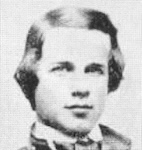 Open main menu
Open main menu
 Open main menu
Open main menu

W.M. Dwight
(1839 - 1877)
Home State: South Carolina
Education: South Carolina Military Academy (the Citadel; one year, 1857),
University of Virginia (c. 1859)
Branch of Service: Staff
Unit: Kershaw's Brigade
Before Sharpsburg
Known by Moultrie, in 1850, then 11, he was living in the Fairfield District, SC with wealthy planter (and probably kin) Theodore L Dubose and his large family, as were his 2 brothers and 187 slaves; his mother had died when he was about 3, but his father Isaac lived, himself a wealthy planter, with 5 of his children and 82 slaves near Charleston, SC. In 1860 Moultrie was a 21 year old school teacher living with his uncle Octavius Theodore Porcher (1828-1873), his family, and a number of students at Willington in the Abbeville District, SC.
He enlisted in Columbia, SC on 22 May 1861 and mustered as a Private in Company A of the 2nd South Carolina Infantry. He was slightly wounded in the hand (or thigh) at First Manassas on 21 July 1861. He was commissioned First Lieutenant of Company K on 13 May 1862, and assigned as Acting Assistant Adjutant and Inspector General to Brigadier General Kershaw in June.
On the Campaign
He was with Kershaw in Maryland, and the General wrote later of action on Maryland Heights:
My thanks are especially due to Captain Holmes, assistant adjutant-general; Lieutenant Dwight, acting adjutant and inspector-general, and Lieutenant Doby, aide-de-camp, for most efficient and intelligent discharge of the staff duties on the field. I regret to say that Lieutenant Dwight was seriously injured by a fall from the rocks [13 September] while communicating a message to General Barksdale ...Dwight was captured in or near Harpers Ferry afterward.
The rest of the War
He was back on duty by November and was wounded by a a piece of shell to the head at Fredericksburg, VA on 13 December. He was promoted to Captain and Assistant Adjutant General, still with Kershaw, on 3 November 1863 and transferred to the staff of Brigadier General James Connor by February 1864. He was captured by cavalry at Spotsylvania, VA on 8 May 1864 and held at Fort Delaware until exchanged about January 1865. He was assigned to Brigadier General Matthew Butler on 25 January 1865, but could not reach his command before the war ended.
After the War
By 1866 he was again a teacher, at the Mount Zion Academy in Winnsboro, SC. In 1870 he was a dry goods merhant there. He was later mayor of Winnsboro and was Principal of the Mount Zion Academy at his death at age 38 in 1877.
References & notes
His service from his Compiled Service Records,1 online from fold3 and Krick.2 The Kershaw quote above from his report of 25 September 1862. Personal details from family genealogists, the US Census of 1850-1870, Fitz Hugh McMaster's History of Fairfield County South Carolina (1946), and the Confederate Veteran (June 1897). His gravesite is on Findagrave. His picture from a photograph, probably in Citadel uniform, contributed to the FamilySearch database by Pennie Smith.
He married Elizabeth Porcher Gaillard (1840-1915) in 1861 in Winnsboro and they had 7 children between 1863 and 1875; 5 died in childhood. She was also his sister-in-law and probably cousin; sister to his brother Charles Stevens Dwight's wife Maria Louisa Gaillard. Moultrie's mother was a Porcher as was Elizabeth's grandmother.
Another of Elizabeth's cousins was Franklin Gaillard (married Catherine Cordes “Tattie” Porcher), who was Lieutenant Colonel of the 2nd South Carolina.
Birth
06/28/1839; Farmington, SC
Death
04/01/1877; Winnsboro, SC; burial in Saint Johns Episcopal Cemetery, Winnsboro, SC
1 US War Department, Compiled Service Records of Confederate Soldiers, Record Group No. 109 (War Department Collection of Confederate Records), Washington DC: US National Archives and Records Administration (NARA), 1903-1927 [AotW citation 32204]
2 Krick, Robert E.L., Staff Officers in Gray; A Biographical Register of the Staff Officers in the Army of Northern Virginia, Chapel Hill: University of North Carolina Press, 2003, p. 119 [AotW citation 32205]